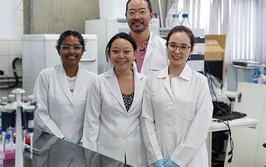Characterization of Protein-Protein Interactions using triple detection size exclusion chromatography (SEC-TD)
Work performed in conjunction with the Institut Pasteur, Paris, France.In this application note, triple detection size exclusion chromatography (SEC-TD) is used to understand the ability of proteins to form ordered, structured complexes. The controlling mechanism behind these protein complexes is fundamental to our knowledge of protein signaling pathways and the physiological responses they control.
Characterization of Protein-Protein Interactions using triple detection size exclusion chromatography (SEC-TD)
The work presented here was performed in conjunction with the Institut Pasteur, Paris, France.
In this application note, triple detection size exclusion chromatography (SEC-TD) is used to understand the ability of proteins to form ordered, structured complexes. The controlling mechanism behind these protein complexes is fundamental to our knowledge of protein signaling pathways and the physiological responses they control.
Introduction
The ability of proteins to form ordered, structured complexes is central to their biological function. Such complexes, which can be homo-oligomers or hetero-oligomers, can control different attributes such as activity, stability and localization. Understanding how these complexes form, and the controlling mechanism behind them, is fundamental to our knowledge of protein signaling pathways and the physiological responses they control. Of particular interest in this field, is the assembly of virulence factor complexes from pathogenic microbes. These factors are secreted by such micro-organisms to facilitate infection, survival and/or colonization of the host, and are therefore crucial for the onset of disease. The ability to target and inhibit these virulence factors could lead to the development of a new generation of anti-microbial therapies. A prerequisite is to understand the mechanisms leading to the formation of hetero- and homo-oligomers. Advanced light scattering detectors combined with liquid chromatography methods were used to characterize the protein-protein interactions of selected microbial virulence factors.

















